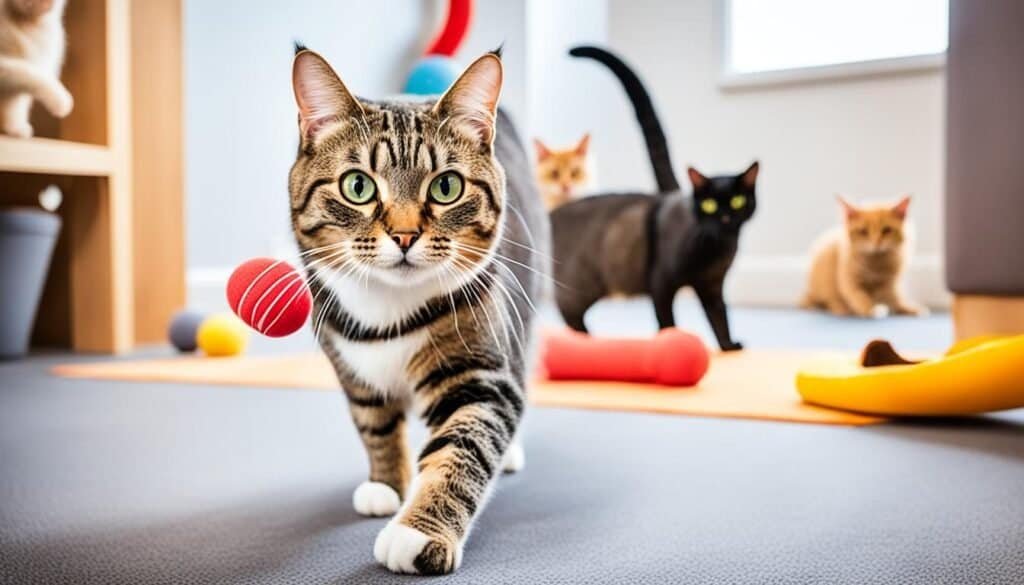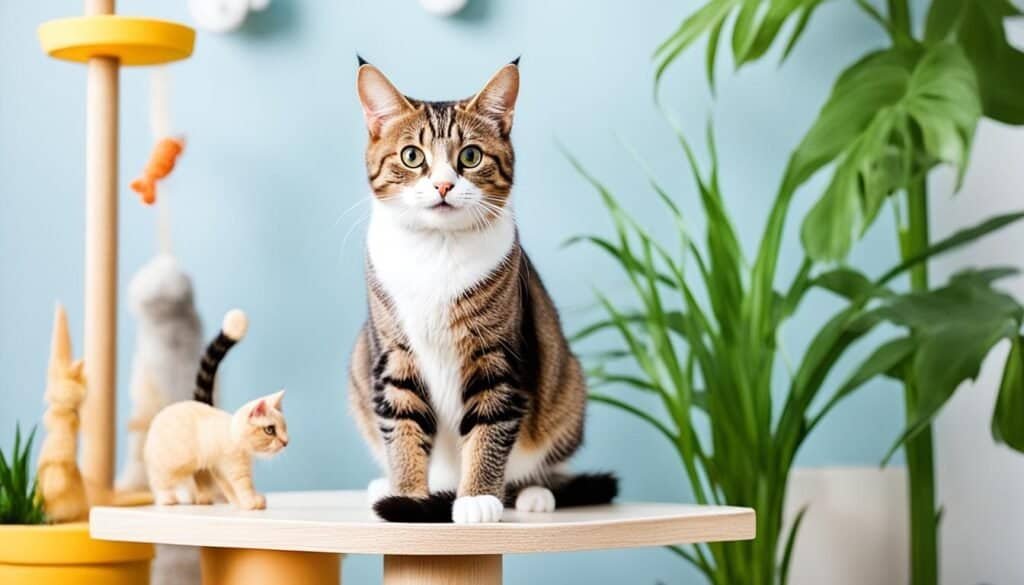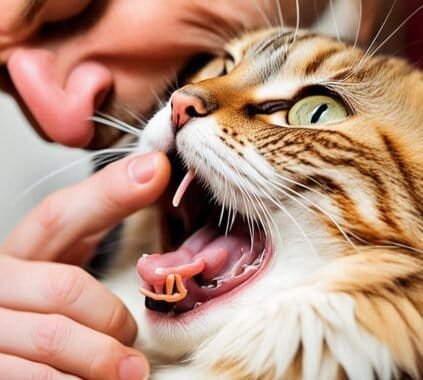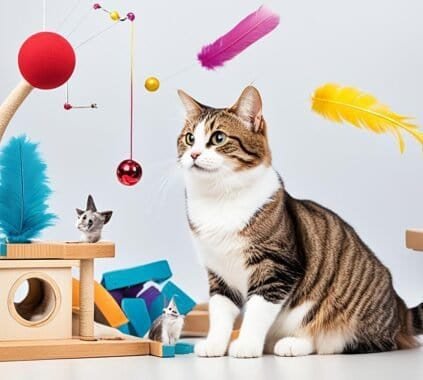Socializing a cat into a new family takes time and patience. Whether you’re introducing a kitten to your home or helping an adult cat adjust to a new environment, understanding cat behavior and employing proper socialization techniques is vital for their well-being.
When bringing a cat into a new home, it’s important to give them space and time to explore their surroundings. Allowing them to develop their own “map” of the house and identify safe places will help build their confidence. Gentle interaction and giving the cat the freedom to approach at their own pace is key.
Creating a safe place where the cat can retreat to if they become frightened is essential. This will provide them with a sense of security and comfort. Rewarding social behavior and ignoring undesirable behavior can also encourage positive socialization.
Key Takeaways:
- Patience and consistency are crucial when socializing a cat into a new home.
- Allowing the cat to explore their new environment at their own pace helps build their confidence.
- Providing a safe place for the cat to retreat to if they become frightened is important.
- Rewarding social behavior and ignoring undesirable behavior can aid in the socialization process.
- Establishing a routine and providing a familiar environment can help build trust with the cat.
Understanding the Importance of Cat Socialization
Cat socialization plays a crucial role in shaping a cat’s behavior and their interactions with humans and other animals. The early experiences of a kitten, including interactions with their mother and littermates, are fundamental for their social development.
During this critical period, kittens should be exposed to various stimuli, such as different people, sights, sounds, and smells, to ensure they become well-adjusted cats. Socialization helps cats develop confidence and form positive relationships with humans. It also aids in their understanding of their place in the household hierarchy.
By providing kittens with opportunities for socialization, we are giving them the foundation to thrive as emotionally balanced and socially adept feline companions.
Why is Cat Socialization Important?
Cat socialization is crucial for several reasons:
- Positive Interactions: Socialized cats are more likely to have positive interactions with humans, making them more enjoyable companions.
- Reduced Fear and Anxiety: Socialized cats are less likely to develop fear or anxiety towards people, other animals, or new environments.
- Prevention of Problem Behaviors: Proper socialization can help prevent common problem behaviors, such as aggression or timidity.
- Health and Well-being: Socialized cats tend to experience lower stress levels and better overall health.
- Enhanced Quality of Life: Socialized cats are more likely to feel confident, secure, and happy in their surroundings.
“Cat socialization is a vital foundation for building strong and lasting bonds between cats and their human companions. It is an investment in a cat’s future well-being and a key factor in ensuring their overall happiness.”
By understanding the importance of cat socialization and implementing effective techniques, we can promote positive behavioral development and enhance the lives of our feline friends.
Introducing Cats to New Environments
Introducing a cat to a new environment can be a challenging process that requires patience and understanding. Cats are highly territorial animals, and a sudden change in their surroundings can cause stress and anxiety. To help your cat adjust and feel more comfortable, it is important to follow a gradual and gentle approach.
Allow Exploration at Their Own Pace
When bringing your cat to a new home or environment, give them the freedom to explore at their own pace. Start by confining them to one room initially, providing all their basic necessities like food, water, litter box, and a cozy place to rest. This allows them to familiarize themselves with a smaller, more manageable space before gradually introducing them to other areas of the house.
Monitor Body Language
During the introduction phase, pay close attention to your cat’s body language. Look for signs of stress or discomfort, such as flattened ears, a swishing tail, or dilated pupils. If you notice these signs, it is important to give your cat space and time to calm down. Avoid forcing interactions and allow them to retreat to their safe space if needed.
“Giving cats the opportunity to explore and adjust to their new surroundings at their own pace is crucial for a smooth transition. It’s important to respect their comfort zones and avoid overwhelming them during this sensitive time.”
Positive Reinforcement
Using positive reinforcement techniques can go a long way in helping your cat feel more comfortable in their new environment. Reward them with treats, praise, and affection when they display relaxed and confident behavior. This will help them associate the new environment with positive experiences, reinforcing their sense of security.
Creating a Safe Space
It is essential to create a designated safe space for your cat in their new environment. This can be a quiet room or corner of the house where they can retreat to when they feel overwhelmed or anxious. Make sure this space has their favorite bed, toys, and scratching posts to provide comfort and familiarity.
- Gradually introduce your cat to new rooms and areas of the house, allowing them to explore at their own pace.
- Monitor your cat’s body language and provide them with a safe space to retreat to if they become stressed or anxious.
- Use positive reinforcement techniques to reward and encourage confident behavior in your cat.
By following these steps and being patient with your cat, you can help them adjust to their new environment and make the transition smoother for both of you.
Building Cat Confidence
Building cat confidence is essential for their overall well-being and successful socialization. When cats feel confident, they are more likely to get along with other cats and exhibit positive social behavior. Understanding the hierarchy within a multi-cat household is crucial in fostering positive relationships.
One important aspect of building cat confidence is providing a safe and secure environment. Cats need a place they can retreat to when they feel anxious or threatened. Ensure each cat has their own resources, such as food bowls, litter boxes, and resting areas, to avoid competition and reduce potential conflicts.
Consistency is key in helping cats feel confident. Establishing routines, such as regular feeding times and consistent interactions, can give cats a sense of stability and predictability. Cats thrive when they have a routine they can rely on, and it helps build their confidence and trust in their environment.
Understanding cat hierarchy is another crucial factor in building cat confidence. Cats have a natural inclination towards establishing a hierarchy within a multi-cat household. By recognizing and respecting this hierarchy, you can help foster positive relationships between cats. Provide each cat with their own space and ensure they have equal access to essential resources.
Positive reinforcement plays a significant role in building cat confidence. Reward desired behaviors and provide encouragement when cats interact peacefully. Use treats, playtime, and praise when cats display appropriate social behavior. This positive reinforcement reinforces their confidence and encourages them to continue exhibiting desirable behaviors.
Remember that building cat confidence takes time and patience. Each cat is unique, and some may require more time to feel comfortable and confident in their environment. Be observant of their body language and adjust your approach accordingly. Celebrate small victories and be consistent in your efforts.

Understanding Cat Body Language
One of the key aspects of cat social behavior is their ability to communicate through their body language. By understanding cat body language, you can gain insight into their emotions and intentions, allowing for better interaction and avoiding potential conflicts.
When observing a cat’s body language, it’s important to pay attention to specific signs that indicate their emotional state. For example, a fluffed tail, dilated pupils, or hissing are signs of distress, indicating that the cat feels threatened or scared. In such situations, it’s essential to provide a calm and safe environment for the cat, allowing them to feel secure.
On the other hand, signs of relaxation and contentment, such as purring, kneading, and a relaxed body posture, indicate that the cat feels comfortable and at ease. These behaviors show that the cat is open to social interaction and can serve as an invitation for positive engagement.
Understanding cat hierarchy is also relevant when interpreting their body language. Cats establish a hierarchical social structure and display specific behaviors to communicate their position within the hierarchy. For example, a dominant cat may display confident body language, such as a straight posture and tail held high, while a submissive cat may exhibit more submissive behaviors like crouching or tucking their tail between their legs.
Interpreting Cat Body Language
Interpreting cat body language requires careful observation and attention to detail. By observing a cat’s overall posture, tail position, ear position, and eye dilation, you can gain valuable insights into their emotional state.
“A cat’s body language is like a window into their world. By understanding their non-verbal cues, we can foster healthier and more fulfilling relationships with our feline companions.”
Remember that each cat is unique, and their body language may vary slightly. It’s essential to observe their behavior in different contexts and consider their individual personalities and experiences.
When interacting with a cat, always approach them gently and allow them to set the pace. Observing their body language and responding appropriately will help create a positive socialization experience and strengthen the bond between you and your feline friend.
Dealing with Cat Aggression
Cat aggression can be a challenging behavior to address during socialization. Understanding the underlying causes of aggression is key to effectively managing and reducing it. Fear, territoriality, or resource guarding are common factors that contribute to cat aggression.
Implementing positive reinforcement techniques can help in addressing cat aggression. Reward-based training, where desirable behaviors are rewarded with treats or praise, can encourage cats to exhibit more appropriate behavior. Gradual exposure to stressful situations can also desensitize cats, helping them overcome their aggressive tendencies.
“Positive reinforcement techniques, such as reward-based training and gradual exposure, can encourage cats to exhibit more appropriate behavior.”
If your cat’s aggressive behavior persists or worsens despite your efforts, seeking guidance from a professional, such as a cat behaviorist or veterinarian, may be necessary. They can provide expert advice and develop a behavior modification plan tailored to your cat’s specific needs.
Cat aggression should not be ignored, as it can lead to potential harm to both humans and other animals. By addressing aggression early and implementing appropriate strategies, you can help your cat become more socialized and ensure a harmonious living environment.
Key Strategies to Address Cat Aggression:
- Identify the underlying cause of aggression (fear, territoriality, or resource guarding).
- Implement positive reinforcement techniques, such as reward-based training.
- Gradually expose your cat to potentially stressful situations to desensitize them.
- Seek guidance from a professional, such as a cat behaviorist or veterinarian, for severe cases.
Addressing cat aggression requires patience, consistency, and a thorough understanding of your cat’s needs and behavior. With the right approach, you can help your cat overcome aggression and foster a more peaceful and harmonious social environment.
Creating a Positive Socialization Environment
Creating a positive socialization environment is crucial for ensuring the well-being and happiness of your cat. By providing a safe, stimulating, and enriching environment, you can help your cat feel comfortable and confident in their surroundings.
One essential aspect of a positive socialization environment is providing appropriate toys, scratching posts, and perching areas to satisfy your cat’s natural instincts. Toys that encourage physical activity and mental stimulation, such as interactive toys or puzzle feeders, can help keep your cat entertained and engaged.
Regular playtime and interactive activities with your cat are also vital for building a strong bond and fostering trust. Take the time to engage in interactive play sessions using toys that mimic prey, such as feather wands or laser pointers. This not only stimulates your cat’s hunting instinct but also helps them build positive associations with you and their environment.

Consistency in training methods is essential when creating a positive socialization environment. Use positive reinforcement techniques, such as treats and praise, to reward desired behaviors and discourage unwanted ones. Remember to be patient and consistent in your approach, as it may take time for your cat to learn and adjust.
Creating a positive socialization environment for your cat is crucial for their overall well-being. By providing a safe and stimulating environment, engaging in regular playtime, and using positive reinforcement techniques, you can help your cat build confidence and develop a positive relationship with their surroundings.
In summary, creating a positive socialization environment involves providing a safe and enriching space for your cat, engaging in regular playtime and interactive activities, and using positive reinforcement techniques. By doing so, you can help your cat feel more comfortable, confident, and content in their environment.
Cat Socialization Tips for Multi-Cat households
Socializing cats in multi-cat households requires extra attention and management. To ensure a harmonious coexistence between the cats, it is important to follow these cat socialization tips:
- Provide individual resources: Each cat should have their own litter box, food bowl, and resting areas. This helps prevent competition and potential conflicts that can arise when resources are shared.
- Introduce cats gradually: When introducing a new cat to the household, it is essential to do so gradually. Use scent swapping techniques by swapping bedding or rubbing towels on each cat to acclimate them to each other’s scents. This helps build familiarity and reduces the likelihood of aggression.
- Use positive reinforcement: Reward positive interactions between the cats with praise, treats, or playtime. This encourages bonding and helps create positive associations with each other’s presence.
- Monitor interactions: Keep a close eye on the cats’ interactions, especially in the early stages of socialization. Separate them if any signs of aggression or tension arise, providing each cat with their own space to retreat to. Gradually increase supervised interactions as the cats become more comfortable with each other.
In multi-cat households, understanding cat hierarchy and feline social behavior is vital. Cats naturally establish their positions based on dominance and submission. By following these cat socialization tips, you can help create a peaceful and harmonious environment for all your feline companions.
The Importance of Cat Socialization in Kittenhood
Cat socialization in kittenhood is crucial for their overall development and future behavior. During the first few weeks of life, kittens learn important social skills from their mother and littermates. Early interactions with humans and exposure to different stimuli are essential for their proper socialization. Positive experiences during this period can shape their behavior and help them become confident and well-adjusted adult cats.
When kittens are born, they rely on their mother for warmth, nourishment, and guidance. Through nursing and grooming, the mother cat establishes a bond with her kittens, teaching them important social behaviors. Siblings also play a role in socializing kittens, as they engage in gentle play-fighting and exploration together, learning boundaries and understanding feline social cues.
To foster proper socialization, it is important to start handling kittens gently and regularly from a young age. This helps them become accustomed to human touch and interaction, making them more comfortable around people as they grow. Introduce them to new experiences such as different surfaces, sounds, and environments gradually, allowing them to explore and adapt at their own pace.
Remember, each kitten has their own unique personality and needs. Some may be more outgoing and eager to explore, while others may be shy and require extra patience and encouragement. It is important to respect their individual differences and provide a safe and nurturing environment for their social development.
Another important aspect of kitten socialization is exposing them to other animals, such as friendly adult cats or well-behaved dogs. This can help kittens learn appropriate social behaviors with different species and prevent fear or aggression towards other animals in the future. However, it is crucial to introduce them gradually, under controlled and supervised circumstances, to ensure their safety and well-being.
Daily playtime and positive reinforcement training sessions with kittens can also aid in their socialization process. Use interactive toys and games to engage them in active play, helping them develop coordination, problem-solving skills, and a bond with their human companions. Rewarding desired behaviors with treats and praise reinforces positive associations and helps them understand what is expected of them.
By focusing on proper socialization during kittenhood, we can help cats grow into well-adjusted and confident adult companions. This includes developing their ability to communicate and engage in positive interactions with humans and other animals. With patience, love, and consistent training, we can set the foundation for a harmonious and enriching relationship with our feline friends.
Understanding Cat Hierarchy
Cats have a hierarchical social structure, where individuals establish their positions based on dominance and submission. This hierarchy plays a significant role in managing and preventing conflicts between cats. By understanding cat hierarchy, we can create a harmonious coexistence among our feline companions.
One important aspect of managing cat hierarchy is providing each cat with their own space and resources. This helps avoid competition and reduces the likelihood of conflicts. Each cat should have their own designated areas for eating, sleeping, and resting.
Building cat confidence is also essential in maintaining a balanced hierarchy. Cats with higher confidence levels are more likely to establish a dominant position, while those with lower confidence may exhibit submissive behavior. Providing positive reinforcement, such as praise and treats, can help boost a cat’s confidence and promote a sense of security.
Observing and understanding feline social behavior is crucial in managing cat hierarchy. By paying attention to their body language and communication signals, we can recognize dominance displays, territorial behaviors, and potential conflicts. This allows us to intervene early and prevent escalating situations.
The key to a successful cat hierarchy is creating an environment that supports positive interactions and reduces stress. Each cat should feel safe and accepted within the household, contributing to a peaceful coexistence.
To summarize, understanding cat hierarchy is essential in managing and preventing conflicts between cats. By providing each cat with their own space, building cat confidence, and being observant of their social behavior, we can create a harmonious living environment for our feline friends.
Conclusion
Cat socialization is an essential part of being a cat owner in the Philippines. By understanding their behavior, body language, and social needs, we can provide a positive socialization experience for our feline companions. Patience is key in allowing cats to adjust to new environments and develop trust at their own pace.
Consistency in training and positive reinforcement techniques can help address cat aggression and promote harmonious relationships between cats. Creating a safe and stimulating environment, with appropriate resources for each cat, is crucial in building their confidence and satisfying their natural instincts.
Understanding cat hierarchy and the importance of early socialization in kittenhood can also contribute to a cat’s overall well-being. Seeking professional help when needed can offer expert guidance and support in ensuring successful socialization and fostering a healthy bond with our beloved cats.
FAQ
How long does it take to socialize a cat into a new family?
What is the best approach to socializing a new cat?
How can I help my cat feel confident in her new environment?
How can I understand my cat’s body language?
How do I address cat aggression during socialization?
How can I create a positive socialization environment for my cat?
How can I help my cats get along in a multi-cat household?
Why is cat socialization important during kittenhood?
What is cat hierarchy, and why is it important to understand?
What is the importance of cat socialization?
Last modified: March 10, 2024














[…] guide to Scottish Folds, a unique and fascinating cat breed with folded ears. If you’re a cat lover in the Philippines, this guide will provide you with valuable insights into the characteristics, history, care, and […]
[…] a cat breed to suit your preferences. In this article, we will delve into the world of cat breeds in the Philippines, exploring their unique characteristics and what sets them […]
[…] Burmese cat is a breed that is well-suited for Philippine homes. With their sociable and adaptable nature, Burmese cats make excellent family pets, bringing […]
[…] proper introductions and gradual introductions are necessary for a harmonious coexistence. Early socialization and positive reinforcement can help ensure a smooth integration of a Bengal cat into a multi-pet […]